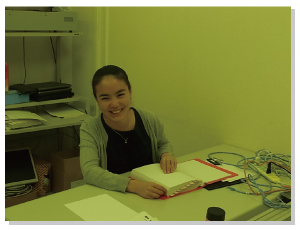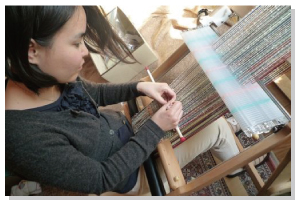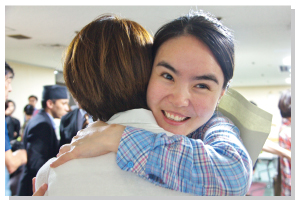- HOME
- Alumni News
- Ariunaa BATSANDAG (17th trainee)
- Ari's Final Report
Ari's Final Report
My discoveries in the land of the rising sun
I clearly remember the joy and excitement I felt, when I received an email, saying that I was selected as the trainee for the 17th Duskin Leadership Training program in Japan. One of the reasons I wanted to participate in this training was to study the employment situation and opportunities for the visually impaired in Japan. Through the program, I gained a lot of knowledge and information about this issue.
During the 10-months training in Japan, I had important discoveries. I learned many useful things. I had very interesting experiences and wonderful memories.
Japanese language class
After coming to Japan, for the first three months, we, the trainees from 6 different countries, had Japanese language class. We had Japanese language and Japanese Braille classes. Soon, we were able to talk about our interesting and new experiences in Japan with our teachers. I admired the teaching skills and effective methods of our teachers.

Accessible society
There is a high level of accessibility in Japan, especially in big cities. Whenever I went out alone, the Braille pedestrian tiles and the audible traffic light signals were very useful. Because station officers provide a guide service for the visually impaired, I could travel alone, even to places far away.
In my country, it is common for us to run across the road. But in Japan I crossed roads in a normal walking pace, without getting nervous.
Running activity in Yoyogi Park
Yoyogi Park is my favorite place in Tokyo. On Sunday mornings, friends from Achilles International Japan came to our hotel to pick us up and guided us to the park. I really enjoyed participating in the club activities. The time we spent together with our friends from the club is unforgettable.
Homestay
I was lucky to have an opportunity to stay in the homes of two families, in Osaka and Kyoto. I experienced and learned more about the lifestyle and culture of Japan.
In Osaka I stayed in the home of Hayashida family. The family had two children. With the children, I tried doing Japanese kanji calligraphy, flew kites and did other fun activities.
I celebrated the New Year in Kyoto, together with my Japanese Takeshita family. Now, whenever I hear someone mention Kyoto, the beautiful images and the wonderful memories spring back to my mind. My Japanese mother was totally blind and she was a very kind person. She was good at cooking, singing and weaving. That is why in February I went back to Kyoto to learn weaving from her, Mama Yachiyo, because I wanted to transfer this knowledge and skill to visually impaired people in my country.
Kyoto has beautiful nature. And when we walked in nature together, or when we went to many interesting places, like the beautiful botanical garden or famous old temples, my Japanese father described what he saw to me and to Mama Yachiyo. And whenever there were things which we could appreciate by sense of touch, he let us know and touch these things. He also wrote captions for all the photos I took in Kyoto.

Individual training
From January to May, I had individual training. My individual training began with computer classes at At Ease.
Towards the end of January, we, the trainees, went to Niigata Prefecture and had a two-day ski training program. In the beginning, I really thought that I would fall over hundreds of times. Because the teacher was very experienced, I fell over only 5 times. Skiing was a unique experience.
In February I had a DAISY training program at ATDO. I learned about different types of DAISY books and learned how to create each type of books. Eventually I created sample DAISY books.
After that, I went back to Kyoto to learn weaving from Mama Yachiyo. I felt happy to see and stay with my Japanese family again. Mama Yachiyo taught me different types of weaving. The training was intensive but enjoyable.
The loom we used was called Flamingo. It was amazing. Even if you cannot see, you can set the threads yourself and weave. I asked whether I could be introduced to the person who invented this loom. I got to meet the person and bought one unit.
In March, I went to Osaka to have training at the Information and Culture Center for the first three weeks, and to the rehabilitation center of Nippon Lighthouse Welfare Center for the Blind for the last week of March,
At the Information and Culture Center, hundreds of volunteers were doing activities for the visually impaired, like transcribing Braille books, recording audio books, and doing face-to-face reading. I admired them. In my country, the Braille as well as audio books are produced by staff. In Japan there are also volunteers who guide the visually impaired, and on many occasions they guided me when I needed to do something.
During the training at the Information and Culture Center, I received a lot of information and knowledge about the library system for the visually impaired, the inclusive education system in Japan and so forth.
For example, I went to the primary school to observe the inclusive class where a blind student was studying together with sighted students. That student was using Braille textbooks and Braille typewriter in the class.
I also went to the university support center for students with disabilities. I found out that this kind of support centers existed in several universities in Japan.
During the training at the Information and Culture Center, I had training from my teacher Ms. Fudo for daily living. The rehabilitation center of the Mongolian National Federation of the Blind is planning to start regular training for daily living in the future, and right now they have a rehabilitation program for walking but there are not enough therapists. So I took this training in order to take home a lot of ideas and information about how daily living could be aided.
Ms. Fudo did not follow a standard program to train me. Instead, she always consulted with me to identify my current daily challenges and adjusted her training to my personal needs. I felt this way, the training would instantly come to fruition.
In April I had training about independent living at Human Care Association. There I met Mr. Nakanishi, who is a reputable and a powerful leader of independent living movement in Japan. I was really impressed and inspired by his speech.
Before this training, I did not have any proper understanding about independent living movement. I lived in the experience room of Human Care Association and learned many important things related to independent living movement. As part of the independent living program, I received a personal assistant service. It was a new experience.
After Human Care Association, I went to Hamamatsu to have training at NPO. Co. Rokuseikai Hamamatsu Workshop with the Disabled-WITH. At WITH, visually impaired people were working happily with sighted staff. The WITH team were thinking about many different ways or solutions so that the blind people could perform certain tasks and were incorporating common, simple tools. For example, to cut a piece of string at a correct length, one side of the table was being used as a measuring tool. Also I was very surprised to see a blind person operating a sewing machine. I had never thought of figuring out a way to do it.
Ms. Shiba taught me many interesting, useful things. She taught me how to make my own white cane, which I am using it now.
I had heard Japan had many famous festivals. During the Golden Week, I had a wonderful opportunity to enjoy the fascinating Hamamatsu Festival.
My plan after returning to my country
I am leaving for my country soon. Back home, I want to make my contributions to the following three activities, together with my circle of peers.
- to create a personal assistance service
- to increase job opportunities for persons with disabilities
- to promote accessible environment.
Acknowledgement
Every single day I spent in Japan was a precious gift for me. I would like to thank everyone from the bottom of my heart for giving me this wonderful opportunity. I have received so much help, support, warmth and generosity, Thank you very much.
Thank you, Japan!





